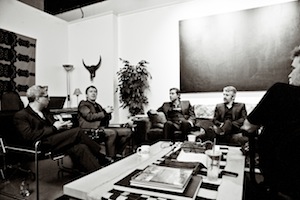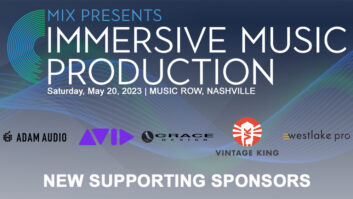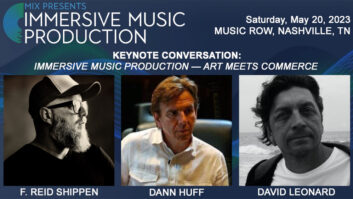
The panel, in Gavin Lurssen’s Hollywood mastering room, from left: Joe Palmaccio, Michael Romanowski, Andrew Mendelson and Lurssen.
Photo: Greg Allen
The job of a mastering engineer today is far different from what it was even 10 years ago. It was once a pretty self-contained world. Tape and sometimes a Pro Tools file came in, and a 1630 went out. Before that a lacquer. Nobody, outside or even inside the industry, was really sure what they did. But their precision, their ears and their musicality brought great value. Nobody questioned that.
Today, a mastering engineer might receive files from eight different sources, in different formats with varied plug-ins, at differing resolutions. Often the project is unlabeled and they become detectives. Then they deliver multiple versions in multiple resolutions for playback on devices ranging from mobile phones to audiophile systems, in streaming and download and physical formats. They are the final stop for the artist and producer, and the ones ultimately responsible for delivering to the consumer.
The four mastering engineers on this month’s cover represent all mastering engineers in a way. But Michael Romanowski, Gavin Lurssen, Joe Palmaccio and Andrew Mendelson (please, Google their backgrounds) have made an effort the past couple of years to share what they’ve learned about the changing world of audio production and distribution. They speak together on panels at events from SXSW to NAMM to AES Latin America; they meet with local professionals in whatever markets will have them; and they are committed to pushing the industry forward and delivering hi-res audio to consumers.
We all met on a Friday morning during Grammy Week at Lurssen’s Hollywood studio. They didn’t really want to talk about loudness wars, extreme gear or Mastered for iTunes. They wanted to talk about decision-making, file formats and what hi-res audio really means. They want to talk about the next generation.
So let’s jump right into mentoring. Each of you can point to a professional who made a difference in your career.
Mendelson: We can. A week and a half into my internship at Sony, I was sitting on the couch and Mark Wilder walked in and said, “What do you want to do?” “Mastering,” I said. “Really? You’re sitting on a couch.” That short conversation changed my perspective. I realized I had to be a little pushy to get in there—he would ask me to leave if he wanted. So I hung around sessions with him and others. I was so nervous about being perceived as cocky that I didn’t appear eager. After that, I would be coming in at 3 a.m., every morning, after the classical guys were done, and I’d spend six hours a day in that room besides being an intern. You find the time to do it.

Gavin Lurssen took apart radios as a kid in South Africa and ended up as a “box boy” at Doug Sax’s Mastering Lab. “The art of balance has always been my interest. Listening to music and always hearing in my head how I would like it to come out.”
Photo: Greg Allen
Lurssen: Mark Wilder is one of the finest mastering engineers to ever exist, in my opinion. He is so mild-mannered, but if you decide you want to know what Mark Wilder knows, he will allow you in, even today. And he’s a sound genius. He won’t push you necessarily. He’s just going to allow it.
Romanowski: Having someone who allows that space to grow and be able to ask questions, so that you are self-exploratory, is invaluable. But you have to be a self-starter. There is a fine line between being cocky and being eager. Paul [Stubblebine] and Ken [Lee] would let me sit in the back of the room at Rocket Labs and I’d watch. Then I would be there till 3 or 4 in the morning. You had to find the time to make it happen, but you had to have the space and someone who would teach you and allow you to explore. We don’t have that these days like we should.
Agreed. And it’s industry-wide.
Lurssen: Mentoring has been replaced by software products. With 200 bucks you can hang a shingle, but it doesn’t mean you have the experience. As professionals, we need to step in and make ourselves available.
Romanowski: Technology has allowed people who haven’t had the opportunity to learn like we did to learn the basics. That’s great. There are plug-ins that emulate all the hardware and analog boxes and everything we use. But they don’t tell people why to do things. They don’t teach. What we do is listen, very deeply and closely, and make decisions. To me it’s all about the why. Why are you doing this? Why do you want it to sound like that?
Palmaccio: There’s a reason the four of us have been hanging together these past couple of years doing outreach. People are often working in silos today. Not communicating. As professionals, we can keep the concept of mentoring going by community building, in an overarching way. It’s important to have an individual, but it also needs the whole recording community.
Romanowski: Our mentors invested in us because they saw that we could carry the torch. A long-term investment in music itself. And craft. That’s what we’re doing, too, trying to pay it forward. It’s not the same as it was, we know that.
Lurssen: There’s a new crop of people coming in who need mentoring, and we have a unique view. SXSW, AES, NAMM, Mexico City—we’re getting out there as a group. It’s not some exclusive thing. We’re just like-minded people.

Andrew Mendelson played guitar and bought a Portastudio as a teen, and later interned at Sony and Telarc, where “they did mostly jazz and classical, and I am so grateful. The best listening skills I could have possibly developed.”
Mendelson: Mentoring extends to your relationship with your clients, too. We’ve all had it happen where something comes in and they want it to sound like the Britney record, or whoever. Then you listen to the mixes and think a) why? And b) that’s not going to happen. You’re going to turn this into a bad imitation of something else when it could be something great in and of itself. That was Britney doing her thing.
So the mix comes in to you. When do you start to form opinions?
All: Instantly.
Lurssen: You always know what something needs to sound like. That’s what drives us all into this job. You take the time to assess what you’re presented with and you make your map. Whoever I’m working with, I always visualize what it needs to sound like in my head. And I always take stock of where we are. So I have two points in space, A and B, and I map the shortest journey with the least amount of stuff from A to B. I want to use as little as possible to get from here to here.
Palmaccio: That’s a simple map he just drew. I think I make mine incredibly complicated. [Laughs]
Romanowski: When people ask how do they get into mastering, I tell them it’s about having an opinion. Be opinionated, that’s point A. Then develop another opinion about where it should be, and that’s point B. At the same time, to find that path, that short distance, you have to be open to what it sounds like and not make any preconceived notions about what you will do. The aural observation is what informs the map.
Mendelson: Before we even start, I like to have a conversation with the producer or artist if they are available and find out what they are going for. The taste. Some people are going for something really aggressive, some more quiet. I have my own opinion, of course, but you have the conversation. It’s their project, and maybe that extra dB of level is important to them.
File formats. You used to get tape and send out a 1630. Today you receive all kinds of files and deliver all kinds of versions.
Mendelson: I feel it’s getting better on the input side. There was a moment there when I would get unmarked discs and they’d tell me there’s an MP3 on there. What artist is this even? And these are label projects where a courier drops it off! But it’s gotten better the last year or two. More attention to detail and labeling. But what amazes me, often with independent artists, is they say the CD manufacturer can’t deal with some weird file format. Well, that’s not the file format we gave you! They’ve ripped it or burned it. You cannot break open our CD case without ripping through a sticker that says Do Not Play! An engineer called me from a listening party one time and said, “This does not sound like what we mastered.” It turns out somebody at the label wanted to add CD text. So they ripped it into iTunes as an MP3, then re-burned it as WAV files! Obviously the spacings are all jacked up at this point. And they send it out!
Romanowski: There’s definitely more coherence on the input side. People are not bringing 44 /16 or 44 /24 that often. It’s way more 2x now—96k/24-bit files. But I’m providing so many different formats for output. I do everything at 96 /24 but give them a 44 /24 so they can do Mastered for iTunes, or 44 /16 so they can upload to TuneCore. If they’re dealing with video, we get them a 48k version. We’re delivering a DDP to most manufacturing.

Joe Palmaccio came up through music appreciation, with a mother who took him to see the likes of Harry James, Buddy Rich, Louis Bellson and Maynard Ferguson. “That started my love of listening.”
Photo: Greg Allen
Palmaccio: I think the DDP player is great because you can send a player and the DDP ref and the client can listen on their computer without going through iTunes. They should listen in the environment they are most comfortable. We had those problems a few years ago where we would send somebody a ref and we don’t know what they did with it. They ripped it into something, and I would have to explain why I can’t make EQ choices based on what they are now telling me. Having the DDP player as a reference point has been a godsend.
High-resolution audio is a hot topic these days, for professionals and consumers. What is it?
Lurssen: We’ve brought it down to MP3, so now a CD is hi-res. [Laughter]

Michael Romanowski credits his experience playing bass onstage and mixing live sound with teaching him how to make decisions. “I was mixing bands I’d never heard and still had to make them sound good. Each night for a couple of years. I learned to develop an opinion on the spot.”
Photo: Greg Allen
Romanowski: The Recording Academy is looking at hi-res as anything 24 /48 and above; that’s been established for film. And then we’re looking at Ultra Hi Res. But it’s just as important that we determine where it came from. You can say that you have an original analog master but you don’t know that it wasn’t an EQ’d safety copy. Or sixth generation. We have to be vigilant as an industry about labeling if we expect the consumer to buy in. Integrity is important. Upsampling is not hi-res. There is truth in advertising, and that’s the only way we can expect consumers to embrace it.
Palmaccio: I would say that hi-res has to be 24 bits. Bits are important. This goes back to the early ’90s when we were just trying to break out of 16 bits. Then 18-bit converters came out, then 20 and 24. Mastering is a game of inches. We improve things in small increments. To go from 16 to 24 is a massive jump. A 48dB difference. The noise floor goes away. So hi-res has to be at least 24 bits. And on sample rate we need to work at 96k. To my ear it’s significantly better. I’m sure we’ll go higher, too. Bigger is better.
Lurssen: Once you get to a sample rate of 192, you’re starting to get closer to what the human brain needs to hear. Double that to 384, and 32-bit—the more samples per second, the higher the ultraharmonic frequencies go. Then the brain doesn’t have to go through the stress of interpolation. When people talk about high resolution, they are first talking about a reduction. But from a marketing standpoint they need to establish a benchmark number. We have to pay attention to that.
Mendelson: The flip side of that is that sometimes there is such focus on the numbers of hi-res that we miss the meaning of it, and the “sound quality” of it. To me, hi-res is the closest representation of the original source.
Lurssen: I like Andrew’s definition. As close to the source as possible. Ultimately, the most success we can offer a client, or a recording, is to make it sound like we were never there. There’s color and flavor to what we do, but it is more felt than heard. There’s definitely vibe, there’s attitude and a style. But there should never be a veil between the recording and the listener. When we offer something to an artist that they can sell with confidence, it should sound like it always existed. It is an art of balance, a balance of the tonal frequency spectrum and an understanding of how consumers will hear it.







